Chalcomima is a genus of moth in the family Gelechiidae. It contains the species Chalcomima hoplodoxa, which is found in Peru.
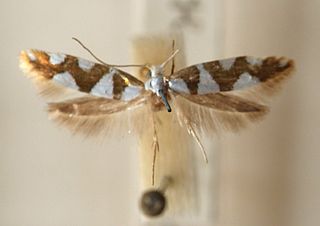
Argyresthia brockeella is a moth of the family Yponomeutidae. It is found in Europe, east Siberia and Japan. The wingspan is 9–12 mm. The head and thorax are white. Forewings are deep coppery-golden; a spot on base of dorsum, a fascia at 1/3, three posterior semioval costal spots and a larger tornal spot shining white; sometimes the fascia is connected with adjacent costal and dorsal spots. Hindwings are grey. The larva is pinkish-brown; head brown; plate of 2 partly blackish-edged.

Plectophila discalis is a moth of the family Xyloryctidae first described by Francis Walker in 1865. It is found in Australia, where it has been recorded from New South Wales, Queensland and Victoria.
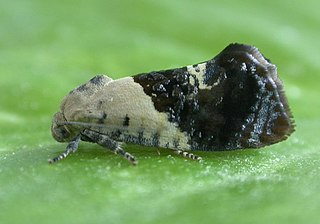
Hypertropha chlaenota is a species of moth of the family Depressariidae first described by Edward Meyrick in 1887. It is found in Australia, where it has been recorded from Victoria, Queensland, New South Wales, the Australian Capital Territory and South Australia.

Stigmella splendidissimella is a moth of the family Nepticulidae. It is found from Scandinavia to Italy and from Ireland to the Crimea. It is not found in the Iberian Peninsula and the Balkan Peninsula.

Stigmella ulmivora is a moth of the family Nepticulidae. It is found in all of Europe, except the Balkan Peninsula.
Nemophora polydaedala is a moth of the Adelidae family. It is found in Queensland.
Nemophora panaeola is a moth of the Adelidae family. It is found in Queensland.
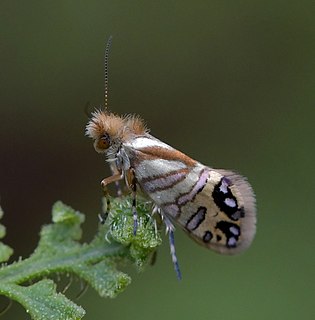
Sabatinca doroxena is a species of moth belonging to the family Micropterigidae. It is endemic to the North Island of New Zealand. This small moth has a colourful forewing pattern with stripes and dots evident. It has been hypothesised that the forewing pattern is intended to resemble a jumping spider in order to allow the adult moth to escape predation. Adults of this species are on the wing from the beginning of September until mid January. It prefers damp but sunny habitat in deep forest, at the forest edge or in open shrubland. Larvae feed on foliose liverwort species including on Heteroscyphus normalis. Adults of this species have been located at the blossoms of flowering Cordyline and Ranunculus species.
Tortyra sporodelta is a moth of the family Choreutidae. It is known from Peru and Costa Rica.
Tortyra chalcobathra is a moth of the family Choreutidae. It is known from Brazil.

Cosmopterix floridanella is a moth of the family Cosmopterigidae. It is found in the United States, the Cayman Islands, Cuba, Jamaica and the US Virgin Islands.
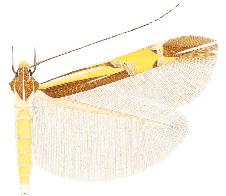
Cosmopterix madeleinae is a moth of the family Cosmopterigidae. It is known from the Galapagos Islands.
Atasthalistis pyrocosma is a moth in the family Gelechiidae. It was described by Edward Meyrick in 1886. It is found on New Guinea and Australia, where it has been recorded from Queensland.
Stegasta cosmodes is a moth of the family Gelechiidae. It was described by Oswald Bertram Lower in 1899. It is found in Australia, where it has been recorded from New South Wales.
Charistica walkeri is a moth in the family Gelechiidae. It was described by Walsingham in 1911. It is found from Panama to Colombia.
Charistica rhodopetala is a moth in the family Gelechiidae. It was described by Edward Meyrick in 1922. It is found in Amazonas, Brazil.
Cryptophasa platypedimela is a moth in the family Xyloryctidae. It was described by Oswald Bertram Lower in 1894. It is found in Australia, where it has been recorded from Queensland.
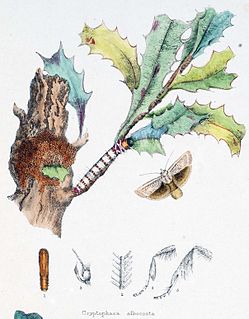
Cryptophasa albacosta, the small fruit tree borer, is a moth in the family Xyloryctidae. It was described by John Lewin in 1805. It is found in Australia, where it has been recorded from New South Wales, Queensland, South Australia, Tasmania and Victoria.
Lichenaula arisema is a moth in the family Xyloryctidae. It was described by Edward Meyrick in 1890. It is found in Australia, where it has been recorded from New South Wales, South Australia and Victoria.






